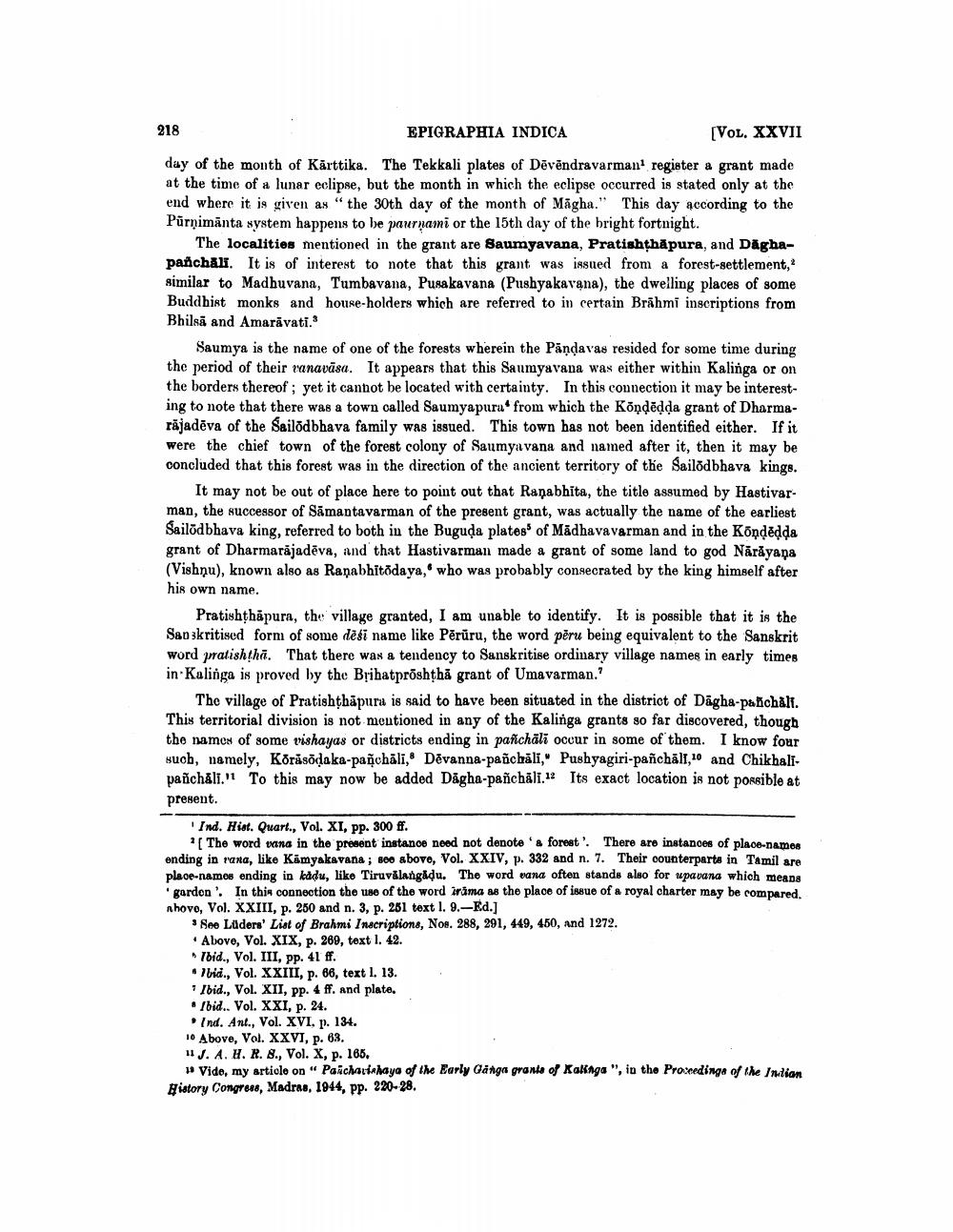________________
218
EPIGRAPHIA INDICA
[Vol. XXVII
day of the month of Kärttika. The Tekkali plates of Dēvēndravarman register a grant made at the time of a lunar eclipse, but the month in which the eclipse occurred is stated only at the end where it is given as "the 30th day of the month of Măgha." This day according to the Purnimānta system happens to be paurnami or the 15th day of the bright fortnight.
The localities mentioned in the grant are Saumyavana, Pratishthapura, and Dāghapanchali. It is of interest to note that this grant was issued from a forest-settlement, similar to Madhuvana, Tumbavana, Pusakavana (Pushyakavana), the dwelling places of some Buddhist monks and house holders which are referred to in certain Brāhmi inscriptions from Bhilsā and Amaravati.
Saumya is the name of one of the forests wherein the Pandavas resided for some time during the period of their vanaväsa. It appears that this Saumyavana was either within Kalinga or on the borders thereof; yet it cannot be located with certainty. In this connection it may be interesting to note that there was a town called Saumyapura' from which the Köņdēdda grant of Dharmaräjadēva of the Sailodbhava family was issued. This town has not been identified either. If it were the chief town of the forest colony of Saumyavana and named after it, then it may be concluded that this forest was in the direction of the ancient territory of the Sailodbhava kings.
It may not be out of place here to point out that Ranabhīta, the title assumed by Hastivarman, the successor of Sāmantavarman of the present grant, was actually the name of the earliest Sailodbhava king, referred to both in the Buguda plates of Mādhavavarman and in the Köņdedda grant of Dharmarajadēva, and that Hastivarman made a grant of some land to god Närāyana (Vishnu), known also as Ranabhitõdaya, who was probably consecrated by the king himself after his own name.
Pratishthapura, the village granted, I am unable to identify. It is possible that it is the Sapskritised form of some deti name like Pērūru, the word pēru being equivalent to the Sanskrit word pratishtha. That there was a tendency to Sanskritise ordinary village names in early times in Kalinga is proved by the Brihatproshthă grant of Umavarman.'
The village of Pratishthapura is said to have been situated in the district of Dagha-pafchalt. This territorial division is not mentioned in any of the Kalinga grants so far discovered, though the names of some vishayas or districts ending in panchāli occur in some of them. I know four such, namely, Koråsõdaka-pañchāli, Dévanna-panchali," Pushyagiri-pañchāli,10 and Chikhalipanchali. To this may now be added Dāgha-panchali. Its exact location is not possible at present.
"Ind. Hist. Quart., Vol. XI, pp. 300 ff.
2 The word vana in the present instance need not denote's forest'. There are instances of place-names ending in rana, like Kimyakavana ; 800 above, Vol. XXIV, p. 332 and n. 7. Their counterparts in Tamil are place-names ending in kadu, like Tiruvalangadu. The word vana often stands also for upavana which means
garden'. In this connection the use of the word irama as the place of issue of a royal charter may be compared. Rhovo, Vol. XXIII, p. 250 and n. 3, p. 251 text 1. 9.-Ed.]
See Lüders' List of Brahmi Inscriptions, Nos, 288, 291, 449, 450, and 1272. . Above, Vol. XIX, p. 269, text I. 42.
Ibid., Vol. III, pp. 41 ff. • Ibid., Vol. XXIII, p. 66, text 1. 13. * Ibid., Vol. XII, pp. 4 ff. and plate. . Ibid. Vol. XXI, p. 24.
Ind. Ant., Vol. XVI, p. 134. 10 Above, Vol. XXVI, p. 63. 11 J. A. H. R. 8., Vol. X, p. 165.
# Vido, my article on Panchacinhaya of the Early Ganga grania of Kalinga ", in the Proxedings of the Indian History Congress, Madras, 1944, pp. 220-28.




